Veritech "Beta" Fighter VFB-9 (A,S)
Veritech "Stalker" ELINT VE-9 (A,S)
(Version
2.0 - Last updated: 05/15/03)
- Background and RPG Statistics by Kenneth Olson
Background Information derived from Robotech.com
and Robotech Technical File
- Robotech Research Picture archive for
VFB-9 "Beta" Fighter
BACKGROUND
Beginnings
The Veritech Beta Fighter can trace its roots to two
separate designs, one as a heavy attack veritech fighter for the
Robotech Expeditionary Forces and the second as TRans-EAth-Deployment
(TREAD) booster designed to give the newly designed VF-6 "Alpha"
fighter long range firepower and additional fuel for spaceborne
operations. Designers of the two separate projects soon came to
the realization that the operational requirements for both missions
could be fulfilled with a single design, thereby greatly simplifying
the already complicated interstellar supply chain which the REF would
have to maintain. The resultant design was aerodynamically
inefficient by itself and relied heavily on a high thrust to weight
ratio to power itself through the atmosphere. However, once
combined with the VF-6 "Alpha" fighter the resultant Legioss
configuration would have the maneuverability of the Alpha while
retaining the raw thrust and firepower of the Beta. Ten
experimental VF-X-7 fighters were built in late 2021 and test flights
began on the Robotech Factory later the next year. Although the
initial tests went well, several accidents occurred during Alpha-Beta
linkup which showed that the technology was not mature enough to
proceed beyond the experimental stage. As expected, the REF
decided to shelve the VF-X-7 project and decided to arm its heavy
assault units with the more mature VF-5 "Condor".
VFB-9A "Beta" Fighter
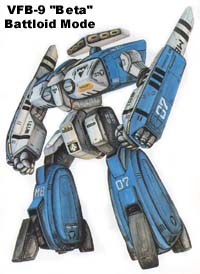 Some 15 years later as the VF-5 "Condor" was reaching
the end of its operational life space, the VF-X-7 was proposed once
again as a replacement fighter. The newly created VFB-9 "Beta"
fighter retained much of the original design in weapons and basic
design; however, the complicated interface machinery and software
necessary for docking with the VF-6 "Alpha" was finally
perfected. The REF satisfied that the technology was now
sufficiently mature, eagerly ordered the VFB-9 into full production on
their mecha facilities on both Tirol and Karbarra.
Some 15 years later as the VF-5 "Condor" was reaching
the end of its operational life space, the VF-X-7 was proposed once
again as a replacement fighter. The newly created VFB-9 "Beta"
fighter retained much of the original design in weapons and basic
design; however, the complicated interface machinery and software
necessary for docking with the VF-6 "Alpha" was finally
perfected. The REF satisfied that the technology was now
sufficiently mature, eagerly ordered the VFB-9 into full production on
their mecha facilities on both Tirol and Karbarra.
The amount of firepower that a single Beta fighter
possesses is staggering. The VFB-9 primary armament consists of
two sets of missile launchers located in either shoulder the the
mecha. Two MM-10 missile launchers each with ten Hammerhead
missiles and ten reloads are mounted in the front chest behind
flip-down missile covers. Immediately behind them are two DD-16
short range launchers with eight Coralsnake
missiles in ready position and eight additional missiles for reloads.
Although both systems can fire in all modes, only the rear DD-16 can
fire while the Beta is hooked up with an Alpha in Legioss configuration.
The VFB-9 "Beta" fighter possess two onboard direct
attack weapons in addition to its internal missile launchers.
Three EP-14 80mm particle beam cannons are mounted on the center intake
and on either of the leg intakes. The EP-14 is the carbine
version of the EP-13 gun pod used on later model VF-6 "Alpha" fighters;
however due to its smaller size, its energy output and range are
appreciable reduced. None of these guns are available in battloid
configuration and the centerline gun is not available when the Beta is
attached to an Alpha in Legioss mode. While the VBF-9 is in
battloid, two devastating arm mounted EU-35 triple barrel energy
weapons are available each one capable of placing over 30 MJ of energy
on target out to an effective range of 1,200 meters. Unfortunately,
because of the massive energy requirement the rate of fire for this weapon is
limited to sixty four rounds per minute.
In addition to its internal missiles and beam weaponry,
the Beta fighter can mount a considerable amount of weaponry on
external stores and in an internal bomb bay. The bomb bay can hold up
to 8,000 kg of ordinance which can include eight long range, 32 x 250 kg
GBU-57 laser-guide high explosive bombs, 16 x 500 kg CBU-62 cluster
bombs, 4 x GBU-27C 2,000 kg laser guided bombs. The
Beta fighter has three hard points on each wing each one can hold one
long range firebird missile,
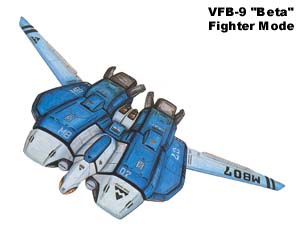 The VFB-9 was armored with the latest Chobham low-mass
composite plating providing immunity from all light anti-mecha weaponry
and excellent protection from medium class (55mm or less) and Invid
annihilation disks. The VFB-9 was given nearly 50% additional
armor over the VF-6 "Alpha" and designed with two massive armshields
which the pilot could use to provide protection from all but the most
massive of anti-mecha weaponry. By the time of the introduction
of the VFB-9, the advanced Chobham composites no longer suffered the
vulnerability to physical attacks like their earlier brethren found on
early models of the VF-6 and the VF-X-7 .
The VFB-9 was armored with the latest Chobham low-mass
composite plating providing immunity from all light anti-mecha weaponry
and excellent protection from medium class (55mm or less) and Invid
annihilation disks. The VFB-9 was given nearly 50% additional
armor over the VF-6 "Alpha" and designed with two massive armshields
which the pilot could use to provide protection from all but the most
massive of anti-mecha weaponry. By the time of the introduction
of the VFB-9, the advanced Chobham composites no longer suffered the
vulnerability to physical attacks like their earlier brethren found on
early models of the VF-6 and the VF-X-7 .
The first combat squadrons of VFB-9 began to form in
2038 and entered into combat with the Mars Division ill fated attempt
to reclaim the Earth in 2039. All of the Mars Division Beta
fighters, approximately 30 in total, were assigned to Horizon dropships
and combined with a VF-6 "Alpha" in Legioss configuration.
The initial stages of the Mars Division attack went as planned with the
squadron of Legioss fighters forming a rapid response group using their
superior firepower and endurance to reinforce groups of
VF-6 "Alpha"
Fighters which because of their short range in spaceborne operations
formed the bulk of the point defense for the capital ships.
Although the Beta fighters performed as design, the Invid overwhelmed
the REF attack forces and quickly destroyed most of Mars Division
within two hours of initiation of the conflict.
VFB-9S "Shadow Beta"
The latest variant of the VFB-9 possesses a RRG Mk-2
shadow cloaking device which is capable of downshifting and absorbing
broadband EM radiation, including emissions from protoculture
use. The protoculture emissions subsequently downshifted is
now out of band from the Invid Protoculture sensors and hence the
VFB-9S is "invisible" to Invid sensors. In addition to the active
stealth characteristics provided by the Mk-2 shadow cloaking device,
the -S model is covered with a fourth generation radar absorbing
material (RAM) which strongly absorbs EM radiation and provides passive
protection should the active system fail. Although the weapon
systems were retained from the -A model, a new low observable
mutli-mode X-band AN/APG-137 radar was added to the mecha. The
system consists of six conformal antenna on the nose, body, and wings thereby further reducing the passive radar cross section.
The radar not only can operate as a fire control for the system, but
also has long range surveillance, ground moving target indicator (GMTI),
synthetic aperture (SAR) and long-range low PRF beyond the horizon
modes.
Production for the new "Shadow Beta" was quickly ramped
up in 2043 for the planned Jupiter and Saturn invasion forces in
2042. An initial production goal of 5,000 units over the next two
years was mandated to allow the inclusion of an all shadow fighter
attack force. Unfortunately, the production goal was not met as only 3,257
VFB-9S units were produced over the next two years leaving the attack
forces with fewer Shadow Betas than initially
requested. Mission planners decided that instead of supplementing
the attack forces with non-shadow equipped Betas, they would use the
allocated hanger space on larger vessels with additional
VF-6S "Shadow
Alphas" and give priority to assigning "Shadow Betas" to Horizont dropships.
VE-9A and -9S Stalker ELINT Beta
With the pending retirement of the ELINT version of the
VF-1 veritech fighter, the REF was in desperate need of a replacement
system. With its large airframe and internal cargo capacity, the
VFB-9 was a logical choice for modification. The resultant VE-9A
is a modified VFB-9A veritech designed with significantly more
electronic warfare (EW) and electronic countermeasures (ECM)
capability. The fuselage was slightly extended to allow the
inclusion of a second person in the cockpit seated to the rear of the
pilot. The electronic countermeasures officer (ECMO) is
responsible for navigation and self-defense, dispensing chaff or flares
if necessary. The bomb bay has be modified to allow seat three
additional ECMO operators which control the onboard AN/ALQ-199 Tactical
Jamming System and hardpoint mounted external jammers and/or weapon
systems.
The ELINT Beta's extensive ECM capability is derived
from its onboard AN/ALQ-199 Tactical Jamming System (TJS) which along with its
associated antenna are placed in the shoulders of the unit replacing the MM-20
missile system and reduces the number of missiles in the DD-16 by half. The onboard system provides broadband
protection against enemy surveillance and fire-control radar. The
system is powered directly from the main protoculture energizers which
allow jamming waveforms of over 95 dBW which will deny radar coverage to the
Invid for approximately 300 km around the unit. In
addition to the onboard jammer, six harpoints on both wings can carry
either additional jamming pods, fuel, weapons, or high speed
anti-radiation missiles (HARMS). These jammers can include
USQ-195 low frequency comlink jammers for use against conventional
forces, USQ-196 radar jammers, or USQ-197 Protoculture jammers which
produce waveforms in band to the Invid's protoculture sensors so great
that it effectively blinds them to other inbound signals.
Although produced in no where near the quantities of
the VFB-9 "Beta" fighter, a total of 127 VE-9A were produced from
2040 until 2043. The units proved themselves extremely effective
in denying the enemy the use of its sensors on the battlespace and as a
result were highly desired by mission planners with VE-9 units flying
on average twice the number of combat missions than their VFB-9
brethren. With the introduction of the shadow cloaking device in
2043, production switched to the VE-9S which was identical to the
earlier model with the addition of an RRG Mark-2 shadow
device. A total of 79 new units were produced for the
invasion of Earth in 2044 and 23 VE-9A models were upgraded to the -S
standard during that same time period.
RPG STATS
- Vehicle Type:
- VF-X-7: Experiment single seat all-weather variable
attack fighter
VFB-9 (A,S): Single seat all-weather variable attack fighter
- VE-9 (A,S): Two seat all-weather electronic attack
variable fighter
- Class: Variable Fighter/Bomber
- Manufacturer: Robotech Expeditionary Force
Crew:
- VF-X-7: One pilot wearing tactical life support
system
VFB-9 (A,S): One pilot wearing tactical life support system
- VE-9(A,S): One pilot and one electronic attack
officer wearing tactical life support system
- Service History
- VF-X-7: Experimental Veritech Fighter served with
the REF from 2021 until 2022
VFB-9A: Served with the REF SPACY and in limited numbers with
the Marines from 2039 until gradually replaced with the introduction of
the VFB-9S model
- VFB-9S: Served with the REF SPACY and in limited
numbers with the Marines from 2043 onwards
- VE-9A: Served with the REF SPACY from 2040 until
gradually replaced with the introduction of the VE-9S model
- VE-9S: Served with the REF SPACY from 2043 onwards
MDC BY LOCATION:
| Location |
VF-X-9 |
VFB-9A |
VFB-9S |
VE-9A |
VE-9S |
| Head |
40 |
50 |
50 |
50 |
50 |
| Hands (2) |
35 |
50 |
50 |
50 |
50 |
| (1) Shoulder/Chest
Retractable Missile Bays (2) |
150 |
200 |
225 |
- |
225 |
| (2) Shoulder/Chest
AN/ALQ-199 Tactical Jamming System (2) |
- |
- |
- |
200 |
225 |
| Forearm Shields (2) |
250 |
300 |
350 |
300 |
350 |
| Upper Arms (2) |
80 |
80 |
100 |
80 |
100 |
| (2) Top sensor suite |
50 |
50 |
60 |
75 |
100 |
| Upper Legs (2) |
80 |
100 |
125 |
100 |
125 |
| Lower Legs (2) |
160 |
175 |
200 |
175 |
200 |
| Wings (2) |
100 |
100 |
125 |
100 |
125 |
| Bomb Bay |
175 |
200 |
200 |
- |
- |
| ECMO reinforced compartment |
- |
- |
- |
200 |
200 |
| Rear Thrusters (3) |
75 |
75 |
75 |
75 |
75 |
| (3) Main Body |
325 |
350 |
375 |
350 |
375 |
| Reinforced Pilot's Compartment |
175 |
200 |
225 |
200 |
225 |
| GU-13S |
50 |
- |
- |
- |
- |
| EP-14 |
- |
50 |
50 |
50 |
50 |
| EU-35 (2) |
- |
75 |
75 |
75 |
75 |
NOTES:
- Depleting 100 MDC of the shoulder missile launchers will destroy
the short range missile launchers 2xMM-20 located in the front of
the Beta fighter.
- Destroying the sensor suite will knockout long range
communications (reduced to 60 miles/96 km range) and long range
radar (reduce to 20 miles) and laser targeting (-1 to strike)
- Depleting the MDC of the main body will destroy the mecha.
SPEEDS:
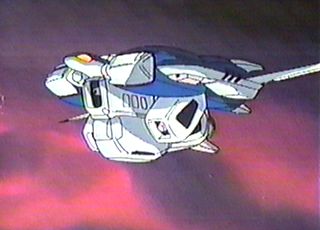 RUNNING, SOLDIER CONFIGURATION:
RUNNING, SOLDIER CONFIGURATION: - 128 kph
- LEAPING, SOLDIER CONFIGURATION:
- 50 ft (15 m) high or 70 ft (21 m) long without thrusters.
- FLYING, SOLDIER CONFIGURATION:
- 482 kph
- FLYING, GUARDIAN CONFIGURATION:
- 500 kph maximum speed in an Terrestrial type atmosphere.
Can also hover in place indefinitely.
- FLYING, FIGHTER CONFIGURATION:
- Max level speed : 700 kph at sea level (Mach 0.7) / 1930 kph at
18,000m (Mach 1.8) / 8900 kph at 45,000 m
Stall speed : 250 kph (VTOL rectification possible)
Initial climb rate : over 40,000m per minute with boosters
Service ceiling : 35 km (unboosted). Beta can be boosted into orbit
- DESIGNED G LIMITS:
- +12.0/-6.5 (Computer overrides at 9.5g)
- MAX ACCELERATION: SPACE
- 4.95 / 2.55 g (light / maximum weight)
- DELTA V:
- 14.3 kps with 10,000 kg of D20 with minimal weapons load
- 7.9 kps with 10,000 kg of D20 with maximum weapons load
- Drop Tanks mounted on the hardpoints will provide an additional delta v of:
- 1300 liters - 1.6 / 0.9 kps (light / maximum weight)
- 2310 liters - 2.8 / 1.7 kps
- 4000 liters - 4.7 / 2.8 kps
-
STATISTICAL DATA:
-
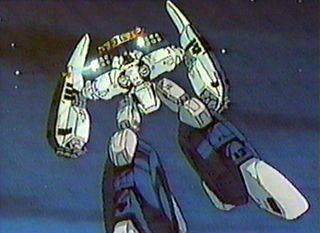 HEIGHT
HEIGHT
- 13.7 m (soldier)
- 8.5 m (guardian)
- 6.1 m (fighter)
- WIDTH:
- 19.5 m wingspan (guardian and fighter)
- 8.5 m (soldier)
- LENGTH:
- 8.0 m (guardian)
- 9.7 m (fighter)
- WEIGHT:
- 29,500 kg empty
- 57,250 kg full load
- PHYSICAL STRENGTH:
- Equal to a P.S. of 60
- CARGO:
- Small compartment behind pilot's seat for personal belongings in
addition to the cyclone storage compartment
- Up to 8,000 kg of equipment can be stored in the bomb bay instead of
weapons
- POWER PLANT:
- 4 x RRL-2D Miniaturized protoculture-cell energizers
- MAX ENGINE THRUST
- [Main] 3 x Pratt & Whitney JG102A Fusion
plasma-air/reaction mass intermix turbines. Max thrust,
356 kN of static thrust (400 kN
augmented) in the atmosphere or 356 kN using internal reaction mass in
space (specific impulse of 5000 sec).
- [Auxiliary] 4 x Turbo-Union ATF-401 miniaturized fusion
plasma-air/reaction mass intermix ramjets. Engines are mounted
in pairs near the elbow joint of the arm for VTOL operations in jet
mode. Each engine is rated to 46.9 kN standard thrust, max
overboost to 91.1 kN each
- FUEL CAPACITY:
- 32 standard canisters of protoculture
- 10,000 liters of D20 for reaction mass
- COMPATIBLE FAST PACKS:
- Armored Beta
WEAPON/DEFENSIVE SYSTEMS:
-
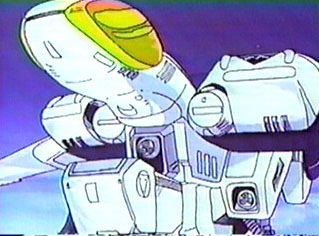 (All VFB-9 and VE-9 models) 3 x EP-14
THREE-BARRELED 80MM PARTICLE GUN POD: Three EP-14 80mm
particle beam cannons are mounted on the center intake and on either
leg intake. Each cannon can fire 170 rounds per minute in
full automatic mode, also capable of firing all three barrels
simultaneously in semiautomatic mode at approximately one shot per
second. This weapon fires 2.4 MJ pulses per barrel in each
mode, drawing power from the aircraft's main energizer. This
gun is the carbine version of the EP-13 gun pod in the later model
Alphas. However due to its smaller size, its energy and range are
appreciably reduced. Three guns are mounted internally (one
along the centerline underneath the cockpit and two on either side
of the intakes of the leg-mounted main-engines). These guns
are not available in battloid and the centerline gun is not available
when the Beta is attached to the Alpha fighter.
(All VFB-9 and VE-9 models) 3 x EP-14
THREE-BARRELED 80MM PARTICLE GUN POD: Three EP-14 80mm
particle beam cannons are mounted on the center intake and on either
leg intake. Each cannon can fire 170 rounds per minute in
full automatic mode, also capable of firing all three barrels
simultaneously in semiautomatic mode at approximately one shot per
second. This weapon fires 2.4 MJ pulses per barrel in each
mode, drawing power from the aircraft's main energizer. This
gun is the carbine version of the EP-13 gun pod in the later model
Alphas. However due to its smaller size, its energy and range are
appreciably reduced. Three guns are mounted internally (one
along the centerline underneath the cockpit and two on either side
of the intakes of the leg-mounted main-engines). These guns
are not available in battloid and the centerline gun is not available
when the Beta is attached to the Alpha fighter.
- PRIMARY PURPOSE: Assault
- SECONDARY PURPOSE: Anti-Mecha
- RANGE: 1200 m
- DAMAGE: 2D4 for each single blast, 1D4*10 for each
triple blast, 1D6*10 for each medium burst, or 3D4*10 for each
full melee burst.
- RATE OF FIRE: Single shots or bursts equal to the
combined attacks of the pilot up to thirty triple blasts or six medium
bursts per melee
- PAYLOAD: Effectively unlimited, powered directly
from the main protoculture energizers
- (VF-X-7 only) 3 x GU-13S
THREE-BARRELED 35MM GUN POD: Three GU-13S guns are mounted internally only
on the VF-X-7, one along the centerline underneath the cockpit (not available
in battloid or Legioss configuration), and two on either side of the intakes
of the leg-mounted main engines (no available in battloid or guardian mode).
This gun is the carbine version of the GU-13 gun pod found in the Alpha
fighter; however, due to its shorter barrel, accuracy, penetration, and range
are appreciably reduced. The weapon fires at a rate of 1400 rounds per minute
with each gun having a 1600
round capacity. Ammunition is a mix of Tungsten-coated
depleted Uranium Armor Piercing Spin-Stabilized Discarding Sabot
(APSSDS), High Explosive Armor Piercing (HEAP) and tracer
rounds.
- PRIMARY PURPOSE: Assault
- SECONDARY PURPOSE: Anti-Mecha
- RANGE: Armor Piercing Spin Stabilized Discarding Sabot
Rounds (APSSDS) 3500 feet (1100 m), High Explosive Armor
Piercing, Standard, and Tracer 3000 ft (900m)
- DAMAGE:
- APSSDS: 3D6 short burst, 5D6 medium burst, 1D6*10
full melee burst
- HEAP: 4D6 short burst, 1D4*10 medium burst, 2D4*10
full melee burst
- Standard: 4D6 short burst, 1D4*10 medium burst, or
2D4*10 full melee burst
- Tracer: Reduce damage by 25%
- RATE OF FIRE: Single shots or bursts equal to the
combined attacks of the pilot.
- PAYLOAD: 200 short bursts, 100 medium, or 50 full melee
- NOTES: APSSDS have critical strikes on
18-20. Tracers add +2 to strike.
-
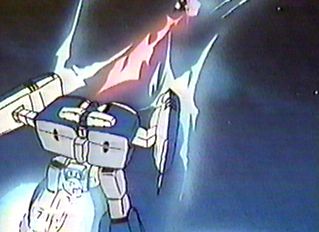 (All VFB-9 and VE-9 models) 2 x
EU-35 TRIPLE-BARRELED ION PULSE CANNONS: The EU-35 is the primary
weapon of the Beta fighter while in battloid mode, as the weapon can not fire
in any other. Both weapons are mounted in the forearm and are capable of
firing 12.5 MJ per cannon. The weapon is powered directly from the main
protoculture generators which coupled with the energy output limits the weapon
to 20 bursts per minute. In addition the weapon lacks range and is
somewhat inaccurate as its compact size limits the number of focusing coils
which would improve accuracy
(All VFB-9 and VE-9 models) 2 x
EU-35 TRIPLE-BARRELED ION PULSE CANNONS: The EU-35 is the primary
weapon of the Beta fighter while in battloid mode, as the weapon can not fire
in any other. Both weapons are mounted in the forearm and are capable of
firing 12.5 MJ per cannon. The weapon is powered directly from the main
protoculture generators which coupled with the energy output limits the weapon
to 20 bursts per minute. In addition the weapon lacks range and is
somewhat inaccurate as its compact size limits the number of focusing coils
which would improve accuracy
- PRIMARY PURPOSE: Assault/Defense
- SECONDARY PURPOSE: Anti-mecha
- RANGE: 1200 m
- DAMAGE: 1D6*10 short burst , 3D4*10 medium burst, or 5D4*10
full melee burst.
- RATE OF FIRE: Up to 16 short bursts, or 5 medium bursts per
melee
- PAYLOAD: Effectively unlimited, powered directly from
the main protoculture energizers
- NOTES: Firing
an arm mounted EU-35 precludes the use of that arm shield to block
incoming attacks
- NOTES-2: GM's can distribute damage in groups of 1D4*10
for medium or full melee bursts to simulate the inaccurate nature of the
weapon
-
 (All
VF-X-7 and VFB-9 Models) 2 x MM-10 MULTI-MISSILE SYSTEM:
Two MM-10 missile launchers each with ten 190mm
Hammerhead missiles and ten additional reload missiles are mounted
in the front chest behind flip-down missile covers. The
launchers can fire in all modes, but are not available in the
combined Legioss configuration. The launchers can carry any of
the Hammerhead missile variants (-A,-B,-C, or -D). These missiles are
replaced by the AN/ALQ-199 Onboard Tactical Jamming System for the VE-9
models.
(All
VF-X-7 and VFB-9 Models) 2 x MM-10 MULTI-MISSILE SYSTEM:
Two MM-10 missile launchers each with ten 190mm
Hammerhead missiles and ten additional reload missiles are mounted
in the front chest behind flip-down missile covers. The
launchers can fire in all modes, but are not available in the
combined Legioss configuration. The launchers can carry any of
the Hammerhead missile variants (-A,-B,-C, or -D). These missiles are
replaced by the AN/ALQ-199 Onboard Tactical Jamming System for the VE-9
models.
- PRIMARY PURPOSE: Assault/Defense
- SECONDARY PURPOSE: Anti-mecha
- RANGE: 8.2 km
- MAX SPEED: Mach 3.0
- DAMAGE:
- High Explosive Armor Piercing (A,C): 1D4*10 MDC per
missile
- Plasma (B,D): 1D6*10 MDC per missile
- RATE OF FIRE: One at a time or in volleys of two, four,
eight, ten, or all twenty.
- PAYLOAD: 20 missiles in each shoulder for a
total of 40
- NOTES: HEAP critical strikes on 17-20, Mark -C
and -D models are +5 to strike against Invid mecha
- (All VE-9 Models)
1 x AN/ALQ-199 TACTICAL JAMMING SYSTEM (TJS): The Stalker
Beta's extensive ECM capability is derive from its on board AN/ALQ-199
Tactical Jamming System (TJS) providing broadband protection, the AN/ALQ-199 will inhibit enemy radars from
detecting the unit, identifies threats, and diverts missiles from hitting their
target. The TJS along with its associated antenna are placed in the
shoulders of the unit replacing the MM-20 missile system and reducing the
number of missiles in the DD-32 by half. The system is powered directly
from the main protoculture energizers which are capable of producing
jamming waveforms of over 95 dBW on inbound
targets. However vehicles with ECCM systems will have an easier time to
located the system through passive direction finding techniques.
- PRIMARY PURPOSE: Electronic Warfare
- SECONDARY PURPOSE: Anti-missile
- RANGE: +300 km for Invid mecha, estimated 150 km for
Robotech Master and Zentraedi units
- BONUS SENSOR INSTRUMENTS: Subtract -10% from read sensory
instruments for every 10 kilometers within 100 kilometers effective range of
the system (eg at 60 kilometers subtract -40%). ECCM systems are +25%.
- BONUS MISSILES: RF homing missiles are -5 to strike; however
anti-radiation missiles are +5 to strike
-
 (All
VF-X-7 and VFB-9 Models) 2 x DD-16 MULTIMISSILE SYSTEM: Located
behind the chest mounted MM-10 missile launchers are two pop-up DD-32 short
range Coralsnake
launchers. Each carries eight missiles in ready position with one
reload of eight missiles. These missiles are available in all flight modes
and configurations, including Legioss configuration.
(All
VF-X-7 and VFB-9 Models) 2 x DD-16 MULTIMISSILE SYSTEM: Located
behind the chest mounted MM-10 missile launchers are two pop-up DD-32 short
range Coralsnake
launchers. Each carries eight missiles in ready position with one
reload of eight missiles. These missiles are available in all flight modes
and configurations, including Legioss configuration.
- PRIMARY PURPOSE: Assault/Defense
- SECONDARY PURPOSE: Anti-mecha
- RANGE: 8.2 km (ballistic trajectory) or 3.5 km (direct
trajectory)
- MAX SPEED: Mach
1.5
-
 DAMAGE:
DAMAGE:
- High Explosive Armor Piercing (A,C): 2D4*10 MDC per
missile
- Plasma (B,D): 2D6*10 MDC per missile
- RATE OF FIRE: One at a time or in volleys of two, four, eight,
or sixteen (from both launchers)
- PAYLOAD: Sixteen Coralsnake missiles
per launcher for a total of thirty two
- NOTES: HEAP have critical strikes on 17-20, Mark
-A and -B are +2 to strike, Mark -C and -D are +3 to strike
against Invid mecha. Subtract -5 for ballistic strikes.
- (All VE-9 Models) 2 x DD-8B MULTIMISSILE SYSTEM:
As the onboard AN/ALQ-199 Tactical Jamming System (TJS) takes up considerable
amount of space on the Stalker Beta fighter, the VE-9 models have reduced
versions of the DD-32 missile system. Each launcher is located behind
the TJS with eight missiles in ready position and no additional reloads.
These missiles are available in all flight modes and configurations, including
Legioss configuration.
- PRIMARY PURPOSE: Assault/Defense
- SECONDARY PURPOSE: Anti-mecha
- RANGE: 8.2 km (ballistic trajectory) or 3.5 km (direct
trajectory)
- MAX SPEED: Mach
1.5
- DAMAGE:
- High Explosive Armor Piercing (A,C): 2D4*10 MDC per
missile
- Plasma (B,D): 2D6*10 MDC per missile
- RATE OF FIRE: One at a time or in volleys of two, four, eight,
or sixteen (from both launchers)
- PAYLOAD: Eight Coralsnake
missiles per launcher
- NOTES: HEAP have critical strikes on 17-20, Mark
-A and -B are +2 to strike, Mark -C and -D are +3 to strike
against Invid mecha. Subtract -5 for ballistic strikes.
-
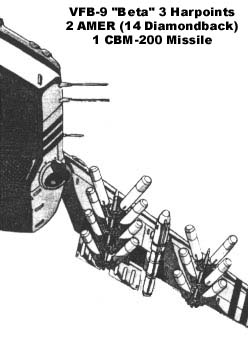 UNDERWING
ORDNANCE: Three hardpoints are mounted on either wing of the Beta
fighter. Weapons can only be placed for spaceborne operations as the
placement of weapons affects the aerodynamics of the mecha drastically in the
atmospheric flight. The Beta fighter must expend all weapons on the
hardponits before transforming into guardian or battloid configurations. Available payloads include, but are not limited to
the following:
UNDERWING
ORDNANCE: Three hardpoints are mounted on either wing of the Beta
fighter. Weapons can only be placed for spaceborne operations as the
placement of weapons affects the aerodynamics of the mecha drastically in the
atmospheric flight. The Beta fighter must expend all weapons on the
hardponits before transforming into guardian or battloid configurations. Available payloads include, but are not limited to
the following:
- MEDIUM RANGE MISSILES: Eight medium range
Diamondback missiles can be stored on
an AMER (Articulating Multiple Ejection Rack) on each inner
hardpoint and six on each outer hardpoint for a total of 14 missiles. The
middle hardpoint can not mount an AMER as the other two hardpoints block
its line of sight.
- PRIMARY PURPOSE: Assault/Defense
- SECONDARY PURPOSE: Anti-Mecha
- MAX SPEED: Mach 3.0 / Mach 6.0 (high speed)
- RANGE: 65 km / 22 km (high speed)
- DELTA-V: 2.0 kps
- DAMAGE: 2D6*10 MDC per missile
- RATE OF FIRE: One at a time or in volleys or two, four,
eight, or fourteen
- PAYLOAD: Eight missiles on inner hardpoint and six on the
outer
- NOTES: +3 to strike, Statistics given for
Diamondback Mk-B missile see missile readout for other options
- LONG RANGE MISSILES: Each hardpoint can carry one standard long
range missile (see Palladium Robotech RPG Books for statistics) or a
single
CBM-200 cluster missile.
- PRIMARY PURPOSE: Assault/Defense
- SECONDARY PURPOSE: Anti-Mecha
- MAX SPEED: Mach 3.2
- RANGE: 65 km
- DELTA-V: 3.5 kps
- DAMAGE: 200 bomblets each does 3D6 MDC, effective blast radius
100 meters
- RATE OF FIRE: One at a time
- PAYLOAD: One long range missile or CBM-200 per hardpoint
- NOTES: +3 to strike. To determine the number of cluster bombs going after a single target. Divide the
number of bomlets (200) by the total number of targets with the effective blast radius
(100 m). Consider that to be the number of bomblets that will attack each target in
a random spread up to a maximum of twenty bomblets per mecha.
- RF/IR JAMMER PODS: Each hardpoint can carry up to one RF
or one IR jamming pod used to divert guided missiles. Only apply the
bonuses to
- PRIMARY PURPOSE: Anti-Missile
- RANGE: 5 km
- NOTES: Subtract -5 from the natural die roll of the
missile attack (before missile bonuses applied) for dumb missiles (+2 to
strike bonus or less), -3 from standard missiles (+3 to strike), -1
from intelligent missiles (+4 to strike or greater). Bonuses do not
stack from multiple jammer pods.
- NOTES-2: Bonuses do not stack from multiple jammer pods and only
apply
- PROTOCULTURE FLARE PODS: Each hardpoint can carry up to
one Protoculture Flare pod. Each Protoculture jammer produces waveforms in band to the Invid's protoculture sensors so great
that it effectively blinds them to other inbound signals.
- PRIMARY PURPOSE: Anti-Invid Sensor
- RANGE: 10 km
- NOTES: Although the Invid will know the direction and
distance of the mecha carrying the Protoculture flare; however, the flare
will blind the Invid from detecting any other targets within the 10 km
effective range.
- CHAFF AND FLARE DISPENSER PODS: Each pod can carry up
to 30 chaff or 30 flares in addition to the onboard systems.
- PRIMARY PURPOSE: Anti-missile
- RANGE: 100 m
- RATE OF FIRE: Up to 10 decoys per attack
- PAYLOAD: 30 decoys per dispenser
- NOTES: In game play only chaff bundles will affect RF missiles
and flares affect IR missiles. The player must declare after the missile
strike, without knowledge of the natural strike roll of the missile attack,
which type of decoy he/she is deploying. For each effective decoy deployed
subtract -3 from the natural die roll for dumb missiles (those with strike
rolls +2 or less), -2 from the natural die from for standard missiles (+3 to
strike), -1 from the natural die roll from intelligent missiles (+4 or
greater to strike). If the natural die roll, with out any strike bonuses
added falls below +5 then the decoys are effective and the missile(s) will
miss their intended target
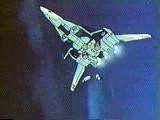 (All VF-X-7 and VFB-9 Models) WEAPONS BAY: The Beta
can carry a nominal load of 4,000 kg of ordnance; however up to
8,000 kg may be loaded double the existing loading.
(All VF-X-7 and VFB-9 Models) WEAPONS BAY: The Beta
can carry a nominal load of 4,000 kg of ordnance; however up to
8,000 kg may be loaded double the existing loading.
- LONG RANGE MISSILES: The weapons bay can hold up to
eight long range missiles of any type (see Palladium Robotech RPG Books
for statistics). Statistics are given for the Derringer Mk-D
long-range missile.
- PRIMARY PURPOSE: Assault/Defense
- SECONDARY PURPOSE: Anti-ship
- MAX SPEED: Mach 3.0
- RANGE: 130 km
- DELTA-V: 5.0 kps
- DAMAGE: 6D6*10 MDC
- RATE OF FIRE: One at a time or in volleys of two
- PAYLOAD: Standard loadout of four long range missiles or
up to a maximum of eight
- NOTES: +3 to strike
- MEDIUM RANGE MISSILES: The weapons bay can hold up to
sixteen medium range missiles of any type (see Palladium Robotech Books
for statistics). Statistics are given for
Diamondback Mk-B missile.
- PRIMARY PURPOSE: Assault/Defense
- SECONDARY PURPOSE: Anti-Mecha
- MAX SPEED: Mach 3.0 / Mach 6.0 (high speed)
- RANGE: 65 km / 22 km (high speed)
- DELTA-V: 2.0 kps
- DAMAGE: 2D6*10 MDC per missile
- RATE OF FIRE: One at a time or in volleys or two, four,
eight, or fourteen
- PAYLOAD: Eight missiles on inner hardpoint and six on the
outer
- NOTES: +3 to strike, Statistics given for
Diamondback Mk-B missile see missile readout for other option
- GRAVITY BOMBS: The weapons bay can hold up to 8,000 kg of
gravity bombs instead of missiles. Up to sixteen 250 kg laser guided
high explosive (HE) bombs, eight 500 kg cluster bombs, or four 1,000 kg
armor piercing (AP) laser guided bombs may be carried.
- PRIMARY PURPOSE: Assault/Defense
- DAMAGE: 3D6*10 MDC for 250 kg HE, 1D4*10 MDC to
everything within blast radius for the 500 kg Cluster Bomb, or 1D4*100 MDC
for the AP bomb
- BLAST RADIUS: 20 m for 250 kg HE, 50 m for 500 kg Cluster
Bomb, and 10 meters for 1,000 kg AP
- RATE OF FIRE: One at a time or in volleys or two
- PAYLOAD: Sixteen 250 kg HE bombs, eight 500 kg cluster
bombs, or four 1,000 kg armor piercing bombs
- NOTES: -5 to strike moving targets on the ground and can
not be used to hit airborne platforms.
- 2 x AN/ALE-55 CHAFF/FLARE DECOY DISPENSERS: Two chaff flare decoy
dispensers are located in either leg of the Beta fighter. Each dispenser
can hold up to 40 decoys apiece with the standard load out consisting of 50%
chaff bundles and 50% flares. The type and number of each decoy is triggered
manually by the pilot.
- PRIMARY PURPOSE: Anti-missile
- RANGE: 100 m
- RATE OF FIRE: Up to 10 decoys per attack
- PAYLOAD: 40 decoys per dispenser
- NOTES: In game play only chaff bundles will affect RF missiles
and flares affect IR missiles. The player must declare after the missile
strike, without knowledge of the natural strike roll of the missile attack,
which type of decoy he/she is deploying. For each effective decoy deployed
subtract -3 from the natural die roll for dumb missiles (those with strike
rolls +2 or less), -2 from the natural die from for standard missiles (+3 to
strike), -1 from the natural die roll from intelligent missiles (+4 or
greater to strike). If the natural die roll, with out any strike bonuses
added falls below +5 then the decoys are effective and the missile(s) will
miss their intended target
- 2 x HANDHELD WEAPONS: The VFB-9 can hold two weapons in
either arm; however, the use of gun pods precludes transformation into
guardian or fighter mode and therefore is not normally used. The Beta can use
any gunpod designed for the VF-6 except for any of the Destabilizer class
weaponry. If a gunpod is used, the EP-13 is normally carried.
The EP-13 can fire 170 rounds per minute in
full automatic mode, also capable of firing all three barrels simultaneously in
semiautomatic mode at approximately one shot per second. This weapon fires 3.2 MJ
pulses per barrel with its own dedicated protoculture cell and capacitor banks
in the 'clip'. This weapon, built into an external shell identical to
that of the GU-13, was developed in 2032 by the REF, but did not see wide use
until 2035.
- PRIMARY PURPOSE: Assault
- SECONDARY PURPOSE: Anti-Mecha
- RANGE: 1200 m
- DAMAGE: 2D4 for each Single blast, 1D6*10 for each triple blast, 2D4*10 for each
medium burst (up to six times per melee), or 4D4*10 for each full melee burst.
- RATE OF FIRE: Single shots or bursts equal to the combined attacks of the pilot.
- PAYLOAD: Conditionally unlimited. The protoculture cell is estimated to
have enough power for 3000 single shots, 1000 triple shots, 300 long bursts, or 100 full
melee bursts.
- HAND TO HAND COMBAT: If necessary, the Beta can engage in
melee combat rather than use a weapon. The VFB-9 can execute most
typical hand to hand combat moves, such as punches, jump kicks,
leap attacks, rolling with impacts, etc.
DAMAGE:
- Punch in Battloid: 3D6
- Punch in Guardian: 3D4
- Kick: 3D6
- Leap Kick: 6D6
- Body Flip/Throw: 3D6
- Body Block/Tackle: 3D6
- Stomp: 3D4 (only effective against small objects)
STANDARD EQUIPMENT FOR ALL MODELS:
-
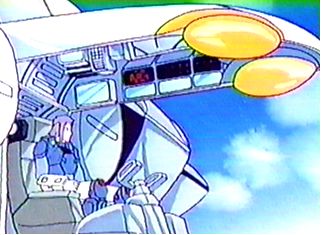 AUTO-PILOT: The
Beta is equipped with a computerized auto-pilot, allowing the
pilot to relax or even sleep during long voyages. The auto- pilot can be programmed with a
single destination or a complex flight plan involving multiple speeds, directions, and
destinations. The onboard computer will alert the pilot when the fighter is near its
destination, and can also be set to automatically signal when sensors detect objects near
the mecha. The auto-pilot was designed with long intra-system space journeys in mind.
AUTO-PILOT: The
Beta is equipped with a computerized auto-pilot, allowing the
pilot to relax or even sleep during long voyages. The auto- pilot can be programmed with a
single destination or a complex flight plan involving multiple speeds, directions, and
destinations. The onboard computer will alert the pilot when the fighter is near its
destination, and can also be set to automatically signal when sensors detect objects near
the mecha. The auto-pilot was designed with long intra-system space journeys in mind.
- CHAFF AND FLARE DISPENSERS AN/ALE-55: 40 chaff and 40
flares are stored in each of the lower legs
- EXTERNAL AUDIO PICKUP: Range: 300 ft (91.5 m). A sound amplification system that
can pick up normal conversation up to 300 feet away.
- HEAT AND RADIATION SHIELDS: Special shielding prevents the penetration of life
threatening head and radiation. A radiation detection and alarm system are linked with the
shields and will sound an alarm if there is a rupture in the shields and what the levels
of radiation are.
- HOMING SIGNAL: The VFB-9 is equipped with a homing
device that enables rescue teams to locate a disabled craft or ejected life pod. The range
of the signal is 400 miles (640 km). Most REF ships and veritechs can locate and track a
homing signal, and the onboard computers will automatically notify their pilots if such a
signal is detected.
- INFRA-RED COUNTERMEASURES: Westinghouse QRC-100 providing
protection from IR guided missiles
- INFRA-RED WARNING RECEIVER: OlDelft Infra-red Warning Receiver (IRWR)
providing rear aspect coverage from IR guided missiles
- LASER RANGE FINDER / TARGETING SYSTEM: Thomson LT-5 multi-frequency laser ranger and designator (Range 30 kilometers)
- LOUDSPEAKER: A loudspeaker system is built into the craft, which can be used to
amplify the pilot's voice up to 100 decibels.
- OPTICS (INFRARED): Phillips All-View multi-band camera system
range 1000 meters. This optical system projects a beam of infrared light
that is invisible to the normal eye, but detectable by the mecha's sensors.
The system allows the pilot to detect hidden/concealed objects by their IR
reflectiveness. The beam will be visible to anyone with IR sensitive optics,
however.
- OPTICS (NIGHTVISION): Phillips All-View multi-band camera system
range 1000 meters. A passive light image intensifier that emits no light
of its own, but relies on ambient light which is electronically amplified to
produce a visible picture.
- OPTICS (THERMAL IMAGER): Phillips All-View multi-band camera
system range 1000 meters. A passive optical heat sensor that detects infrared
radiation projected by warm objects and converts that data into a false-color
visible image. The system enables the pilot to see in the dark, in shadows,
and through smoke, and also adds a +10% bonus to pilots using a tracking
skill.
- RADIO/VIDEO COMMUNICATION: Long range, directional communications system with
satellite relay capabilities. Range: 600 miles (960 km) or can be boosted indefinitely via
satellite relay.
- RADAR WARNING RECEIVER: Marconi Radar Warning Receiver (RWR)
- SELF-DESTRUCT: To prevent capture of an advance variable fighter by the enemy,
the pilot can activate the VBF-9 self-destruct system, which will cause the fighter
to explode after a delay of up to 60 minutes (time is set by the pilot). The explosive
damage is contained within a 20 foot (6 m) area and inflicts 1D6*10 M.D. to everything
within the radius of the explosion. All internal systems are obliterated. The escape pod
will be automatically ejected prior to the explosion unless the pilot overrides the
ejection sequence.
- SMOKE DISPENSERS: Enough smoke is stored for 30 second
of continuous coverage. After 2040, smoke was formulated to cover
protoculture emissions, hence providing temporary protection for the Beta
fighter
- STANDARD SURVIVAL KIT: All REF veritechs come equipped with a portable survival
kit. Inside the small reinforced box is a medium-sized flashlight, two hand flares, one
rocket flare, a compass, infrared distancing binoculars, a small mirror, a pocket knife,
dehydrated and concentrated food (can be stretched into a five day supply for one person)
and basic first aid items (aspirin, bandages, disinfectants, etc.)
- TACTICAL LIFE SUPPORT SYSTEM: The VBF-9 cockpit is pressurized, and also provides
additional air feeds to the pilot's flight suit that provides him with pressurized
breathing. The REF flight suit also contains an upper and lower g-suit that promotes blood
circulation even during high-g turns, thus decreasing the possibility of pilot's blacking
out in combat.
STANDARD EQUIPMENT FOR ALL VFB-9 MODELS:
- ACTIVE SENSOR JAMMER: Westinghouse ALQ-250(V) internal
ECM providing broadband protection. Estimated system effective radiative
power 50 dBW
- COMBAT COMPUTER: The IBM-210 combat computer tracks and identifies specific enemy
targets, and has a database of over 10,000 images stored in memory. The computer can
identify and track up to 250 targets simultaneously.
- RADAR (SHORT RANGE / FIRE CONTROL): Hughes APG-113 X-band
pulse-Doppler, providing spherical long-range detection and tracking of
targets at all altitudes. (Range 150 km against a 0 dBsm "Invid sized" target)
STANDARD EQUIPMENT FOR ALL VE-9 MODELS:
- ACTIVE SENSOR JAMMER: The Raytheon AN/ALQ-199 Tactical Jamming System (TJS)
is mounted in either shoulder providing broadband protection against enemy
surveillance and fire-control radar. Estimated system effective
radiative power of over 95 dBW which will deny radar coverage to the Invid for
approximately 300 km around the unit.
- COMBAT COMPUTER: The IBM-500 combat computer tracks and identifies
specific enemy targets, and has a database of over 10,000 images stored in
memory. The computer can identify and track up to 5,000 targets
simultaneously.
- RADAR (SHORT RANGE / FIRE CONTROL): Hughes APG-113 X-band
pulse-Doppler, providing spherical long-range detection and tracking of
targets at all altitudes. (Range 150 km against a 0 dBsm "Invid sized" target)
- RADAR (SURVEILLANCE): Westinghouse APY-7 multi-band interleaved-multi-mode radar system, providing spherical
very-long-range detection and tracking of targets at all altitudes in addition to medium
range imaging and target identification. This system includes passive modes for
"stealthy" detection of targets. (Range 500 km against a 0
dBsm "Invid sized" target)
- SIGNAL ANALYZER: Thomson ASD-52 has the capability of
receiving inbound EM signals and classify frequency direction of emitter
STANDARD EQUIPMENT FOR THE VFB-9S and VE-9S:
- EM-ABSORBING SKIN COVER: RRG Mk 3 EM-Absorbing skin
cover strongly absorbing EM radiation from radio through ultra-violet
wavelengths, and emitting only weakly in these bandwidths
- PROTOCULTURE SHADOW: RRG Mk-2 four-dimensional
distortion field generator (downshifts and dampens protoculture radiation)
emitting only weakly in these wavebands. NOTE: . Once the mecha has lost
half of its main body MDC, there is a 50% chance that the stealth system will
fail every time the main body of the craft is hit. Once the stealth system has
failed, it will not work again until repaired at a REF base
- RADAR (SHORT RANGE / FIRE CONTROL): Hughes AN/APG-137 X-band
multi-mode X-band pulse Doppler radar, providing detection and tracking of
targets at all altitudes. (Range 200 km against a 0 dBsm "Invid sized"
target).
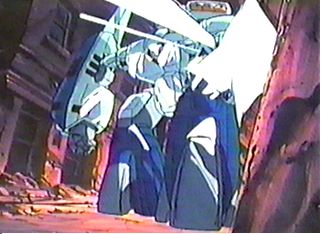 COMBAT BONUSES FOR VFB-9
COMBAT TRAINING:
COMBAT BONUSES FOR VFB-9
COMBAT TRAINING:
- 2 attacks per melee (plus those of the pilot)
- Add one additional action/attack at levels six and twelve
- +2 on initiative (VFB-9S)
- +1 to strike (+2 for VFB-9S)
- +3 to parry
- +2 to dodge in solder and guardian and +4 in jet mode.
- +2 to roll with a punch or fall with an impact, reducing damage
by half
- Critical strike same as pilot's hand-to-hand
COMBAT BONUSES FOR VFB-9 BASIC TRAINING:
- 1 attack per melee (plus those of the pilot)
- Add one additional action/attack at levels seven and thirteen
- +1 on initiative (VFB-9S)
- +0 to strike (+1 for VFB-9S)
- +2 to parry
- +1 to dodge in solder and guardian and +3 in jet mode.
- +1 to roll with a punch or fall with an impact, reducing damage
by half
- Critical strike same as pilot's hand-to-hand
COMBAT BONUSES FOR VE-9 ELECTRONIC ATTACK TRAINING:
- 2 attacks per melee (plus those of the pilot and electronic
attack officer)
- Add one additional action/attack at levels six and twelve
- +2 on initiative (VE-9S)
- +1 to strike (+2 for VE-9S)
- +3 to parry
- +1 to dodge in solder and guardian and +3 in jet mode.
- +2 to roll with a punch or fall with an impact, reducing damage
by half
- Critical strike same as pilot's hand-to-hand
COMBAT BONUSES FOR VE-9 ELECTRONIC BASIC TRAINING:
- 2 attacks per melee (plus those of the pilot and electronic
attack officer)
- Add one additional action/attack at levels six and twelve
- +1 on initiative (VE-9S)
- +0 to strike (+1 for VE-9S)
- +2 to parry
- +0 to dodge in solder and guardian, +2 in jet mode.
- +1 to roll with a punch or fall with an impact, reducing damage
by half
- Critical strike same as pilot's hand-to-hand
Random Hit Locations
When there is an equal chance of
hitting both sides from 1D6
- 1-3 hits the right side
- 4-6 hits the left
When there is a preferred side, roll
1D10
- 1-8 hits the preferred side
- 9-10 hits the opposite side
| Beta
Fighter |
FRONT
|
BACK
|
SIDES
|
TOP
|
BOTTOM
|
| Head (Main
Body) |
- |
- |
- |
01-05 |
- |
| Hands
(Forearms) |
- |
01-05 |
- |
- |
- |
| Shoulder
Missile Bays (Main Body) |
01-25 |
- |
01-19 |
06-35 |
01-15 |
| Forearm Shields (Upper Arms) |
- |
- |
20-29 |
36-46 |
16-25 |
| Upper Arms
(Main Body) |
26-30 |
- |
30-34 |
- |
26-30 |
| Top Sensor
Suite (Main Body) |
- |
- |
- |
47-49 |
- |
| Upper Legs
(Main Body) |
- |
- |
- |
- |
31-35 |
| Lower Legs
(Upper Legs) |
- |
06-45 |
35-44 |
50-64 |
36-55 |
| Wings
(Forearm Shields) |
31-49 |
46-65 |
45-49 |
65-74 |
56-65 |
| Bomb Bay
(Main Body) |
- |
66-70 |
- |
- |
66-75 |
| Rear
Thrusters (Main Body) |
- |
71-89 |
- |
- |
- |
| Main
Body |
50-87 |
90-95 |
50-80 |
75-84 |
76-89 |
| Pilot's
Compartment |
88-95 |
- |
81-90 |
85-95 |
90-95 |
| GU-13/EP-14 |
97-00 |
- |
91-95 |
- |
96-00 |
| EU-35 |
- |
96-00 |
96-00 |
96-00 |
- |
| Beta Guardian |
FRONT
|
BACK
|
SIDES
|
TOP
|
BOTTOM
|
| Head (Main
Body) |
- |
- |
- |
01-05 |
- |
| Hands
(Forearms) |
- |
01-05 |
- |
- |
- |
| Shoulder
Missile Bays (Main Body) |
01-25 |
- |
01-19 |
06-35 |
01-15 |
| Forearm Shields (Upper Arms) |
26-30 |
- |
20-29 |
36-55 |
16-25 |
| Upper Arms
(Main Body) |
- |
- |
30-34 |
- |
26-30 |
| Top Sensor
Suite (Main Body) |
- |
06-10 |
- |
56-60 |
- |
| Upper Legs
(Main Body) |
31-35 |
11-20 |
- |
- |
31-40 |
| Lower Legs
(Upper Legs) |
36-50 |
21-50 |
35-44 |
- |
41-65 |
| Wings
(Forearm Shields) |
51-55 |
51-55 |
45-49 |
- |
66-69 |
| Bomb Bay
(Main Body) |
- |
56-60 |
- |
- |
70-75 |
| Rear
Thrusters (Main Body) |
- |
61-65 |
- |
61-65 |
- |
| Main
Body |
56-87 |
66-95 |
50-80 |
66-84 |
76-89 |
| Pilot's
Compartment |
88-98 |
- |
81-90 |
85-95 |
90-95 |
| GU-13/EP-14 |
99-00 |
- |
91-95 |
- |
96-00 |
| EU-35 |
- |
96-00 |
96-00 |
96-00 |
- |
| Beta Battloid |
FRONT
|
BACK
|
SIDES
|
TOP
|
BOTTOM
|
| Head (Main
Body) |
01-02 |
- |
01-02 |
01-10 |
- |
| Hands
(Forearms) |
03-05 |
01-04 |
03-05 |
- |
- |
| Shoulder
Missile Bays (Main Body) |
06-23 |
05-20 |
06-15 |
11-49 |
01-09 |
| Forearm Shields (Upper Arms) |
24-33 |
21-25 |
16-40 |
50-59 |
10-19 |
| Upper
Arms (Main Body) |
34-38 |
26-35 |
41-45 |
60-69 |
20-25 |
| Top Sensor
Suite (Main Body) |
39-43 |
36-40 |
46-50 |
70-79 |
- |
| Upper Legs
(Main Body) |
44-53 |
41-50 |
51-55 |
- |
26-35 |
| Lower Legs
(Upper Legs) |
54-68 |
51-65 |
56-75 |
80-81 |
36-66 |
| Wings
(Forearm Shields) |
69-70 |
66-67 |
76-77 |
- |
67-68 |
| Bomb Bay
(Main Body) |
- |
- |
- |
- |
69-72 |
| Rear
Thrusters (Main Body) |
- |
68-75 |
- |
82-93 |
- |
| Main
Body |
71-90 |
76-90 |
78-90 |
94-98 |
73-90 |
| Pilot's
Compartment |
91-95 |
91-95 |
91-95 |
- |
91-95 |
| GU-13/EP-14 |
- |
- |
- |
- |
|
| EU-35 |
96-00 |
96-00 |
96-00 |
99-00 |
96-00 |
REFERENCES USED IN THIS DESIGN
- Palladium Books: The Sentinels VBF-1 Beta Fighter
- Robotech.com: Veritech Beta VFB-9
- Robotech Technical Files: VF-12 (A,B,S) Veritech Beta Fighter
- Robotech Technical Files: Stalker Veritech ELINT Aircraft
Back to Mecha Home
 Some 15 years later as the VF-5 "Condor" was reaching
the end of its operational life space, the VF-X-7 was proposed once
again as a replacement fighter. The newly created VFB-9 "Beta"
fighter retained much of the original design in weapons and basic
design; however, the complicated interface machinery and software
necessary for docking with the VF-6 "Alpha" was finally
perfected. The REF satisfied that the technology was now
sufficiently mature, eagerly ordered the VFB-9 into full production on
their mecha facilities on both Tirol and Karbarra.
Some 15 years later as the VF-5 "Condor" was reaching
the end of its operational life space, the VF-X-7 was proposed once
again as a replacement fighter. The newly created VFB-9 "Beta"
fighter retained much of the original design in weapons and basic
design; however, the complicated interface machinery and software
necessary for docking with the VF-6 "Alpha" was finally
perfected. The REF satisfied that the technology was now
sufficiently mature, eagerly ordered the VFB-9 into full production on
their mecha facilities on both Tirol and Karbarra. The VFB-9 was armored with the latest Chobham low-mass
composite plating providing immunity from all light anti-mecha weaponry
and excellent protection from medium class (55mm or less) and Invid
annihilation disks. The VFB-9 was given nearly 50% additional
armor over the
The VFB-9 was armored with the latest Chobham low-mass
composite plating providing immunity from all light anti-mecha weaponry
and excellent protection from medium class (55mm or less) and Invid
annihilation disks. The VFB-9 was given nearly 50% additional
armor over the  RUNNING, SOLDIER CONFIGURATION:
RUNNING, SOLDIER CONFIGURATION:  HEIGHT
HEIGHT  (All VFB-9 and VE-9 models)
(All VFB-9 and VE-9 models) (All
VF-X-7 and VFB-9 Models) 2 x MM-10 MULTI-MISSILE SYSTEM:
Two MM-10 missile launchers each with ten
(All
VF-X-7 and VFB-9 Models) 2 x MM-10 MULTI-MISSILE SYSTEM:
Two MM-10 missile launchers each with ten  (All
VF-X-7 and VFB-9 Models) 2 x DD-16 MULTIMISSILE SYSTEM: Located
behind the chest mounted MM-10 missile launchers are two pop-up DD-32 short
range
(All
VF-X-7 and VFB-9 Models) 2 x DD-16 MULTIMISSILE SYSTEM: Located
behind the chest mounted MM-10 missile launchers are two pop-up DD-32 short
range  DAMAGE:
DAMAGE:
 UNDERWING
ORDNANCE: Three hardpoints are mounted on either wing of the Beta
fighter. Weapons can only be placed for spaceborne operations as the
placement of weapons affects the aerodynamics of the mecha drastically in the
atmospheric flight. The Beta fighter must expend all weapons on the
hardponits before transforming into guardian or battloid configurations. Available payloads include, but are not limited to
the following:
UNDERWING
ORDNANCE: Three hardpoints are mounted on either wing of the Beta
fighter. Weapons can only be placed for spaceborne operations as the
placement of weapons affects the aerodynamics of the mecha drastically in the
atmospheric flight. The Beta fighter must expend all weapons on the
hardponits before transforming into guardian or battloid configurations. Available payloads include, but are not limited to
the following:
 (All VF-X-7 and VFB-9 Models) WEAPONS BAY: The Beta
can carry a nominal load of 4,000 kg of ordnance; however up to
8,000 kg may be loaded double the existing loading.
(All VF-X-7 and VFB-9 Models) WEAPONS BAY: The Beta
can carry a nominal load of 4,000 kg of ordnance; however up to
8,000 kg may be loaded double the existing loading.
 AUTO-PILOT: The
Beta is equipped with a computerized auto-pilot, allowing the
pilot to relax or even sleep during long voyages. The auto- pilot can be programmed with a
single destination or a complex flight plan involving multiple speeds, directions, and
destinations. The onboard computer will alert the pilot when the fighter is near its
destination, and can also be set to automatically signal when sensors detect objects near
the mecha. The auto-pilot was designed with long intra-system space journeys in mind.
AUTO-PILOT: The
Beta is equipped with a computerized auto-pilot, allowing the
pilot to relax or even sleep during long voyages. The auto- pilot can be programmed with a
single destination or a complex flight plan involving multiple speeds, directions, and
destinations. The onboard computer will alert the pilot when the fighter is near its
destination, and can also be set to automatically signal when sensors detect objects near
the mecha. The auto-pilot was designed with long intra-system space journeys in mind.  COMBAT BONUSES FOR VFB-9
COMBAT TRAINING:
COMBAT BONUSES FOR VFB-9
COMBAT TRAINING: